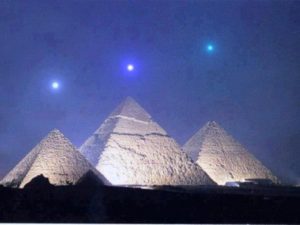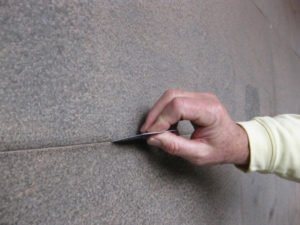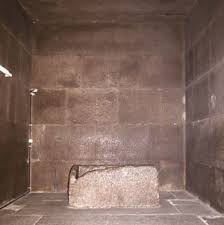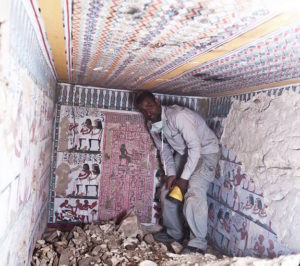Whilst there are a number of ancient structures located around the world, the most iconic and intriguing one has to be the Great Pyramid of Giza.
I will dedicate many posts to the Giza plateau but my first one has to be directly related to the widely disputed function of the Great Pyramid.

Let’s look at what the common consensus says about the oldest of the 7th Wonders of the World. Based on a marking found in an inner chamber referencing the fourth dynasty Egyptian Pharaoh Khufu, Egyptologists state that the Great Pyramid was built as a tomb to Khufu around 2,600BC. Sofar, potentially logical and widely accepted but we’ll review it later in the article.
I want to now look in more details at the size of this so-called tomb. The present height of the pyramid is 138.8 meters (although it is estimated that before erosion took its course, the pyramid stood at 146.5 meters height). The mass of the pyramid is estimated at 5.9 million tonnes and the volume is roughly 2,500,000 cubic meters. Whatever its function, it must have taken huge effort to cut, transport and assemble the estimated 2.3 million blocks which it took to create this so-called mausoleum.
If you have had the chance like me to visit the Giza plateau, you will agree  that the accuracy of the masonry is truly mind blowing. Based on Cole Survey of 1925, the four sides of the base have an average error of only 58 millimetres in length, the base is horizontal and flat to within 15 mm. The precision of the assembly of the stones is so perfect that it is impossible to place a sheet of paper in between the stones. I was there and tried (that’s not my hand by the way)!
that the accuracy of the masonry is truly mind blowing. Based on Cole Survey of 1925, the four sides of the base have an average error of only 58 millimetres in length, the base is horizontal and flat to within 15 mm. The precision of the assembly of the stones is so perfect that it is impossible to place a sheet of paper in between the stones. I was there and tried (that’s not my hand by the way)!
Petrie, who was one of the most important and influential figures in the history of Egyptology, has produced an enormous amount of archaeological evidence and data over his 60 years of research. Some precise mathematical equations were used to calculate every aspects of this architecture. The sides of the square base are closely aligned to the four cardinal compass points. The base of the pyramid is a square whose perimeter is equal to the circumference of a circle with a radius equal to the height of the great pyramid. If one divides the perimeter of the

Pyramid by its height, one obtains 2xpi. The notion of Pi can be seen over and over again throughout the design of the pyramid. Many therefore believe that the Pi was purposely included in the design whilst others claim that it would have been impossible for ancient Egyptians to know and understand the notion of Pi.
How could Egyptians have known in 2,600BC this mathematical irrational number when it was Williams Jones, a Swiss Born mathematician, who invented Pi in the 18th century?
How can this help us figure out potential functions of the Great Pyramid? It doesn’t directly of course, apart from the fact that it tells us that the builders of the Great Pyramid were great mathematician and architects and therefore defies the common belief of what was known and not known in ancient times. If we are wrong about the ingenuity of those designers, we might also be wrong in believing that the pyramids were built as tombs to great pharaohs. If Khufu was not the builder, then we might also be wrong in dating the Pyramid. Could it be much older than 2,600BC?
Let s therefore open our minds and explore the various theories related to this mystery.
Why not a Tomb
No mummies or human remains were ever found inside the pyramid, nor in the chambers.
No hieroglyphs, nor any other type of inscription, nor paintings were inside the pyramid. In other tombs, walls are covered with paintings and glyph describing the life and achievements of their great Pharaohs.

The name of Khufu was not found engraved in or near the King’s chamber but in a 5th chamber on a top roof, a tiny engraving left supposedly by the workers who build the pyramid. The only object found in the King’s chamber is a rectangular granite sarcophagus which is roughly finished and has a broken missing top.
The fact that Egyptologists named the chambers “King and Queen’s chambers” definitely set the tone in the public’s mind and somehow already dictates the function of the pyramid.
It is important to know that only one statue of Khufu was ever found in all Egypt; and the dimensions are tiny: 7.com high, 2.9 com long and 2.6 cm deep. It seems totally disproportionate to have only 1 statue of such a megalomaniac Pharaoh. The statue was not even found in Giza but in Abysdos (which is 6 hours drive south of Cairo) by Petrie in 1903. Something doesn’t seem coherent.
I hear you say that looters must have gone it and taken all the treasures but it is very unusual for looters to leave no trace at all, normally sarcophagus are left behind and gold, jewelry and other valuables are taken. Also where is the actual top of the sarcophagus? This must have weight substantially: so how and why would have looters taken the lead of the sarcophagus? The picture below shows what kind of scene looters would normally leave behind: broken fragments, skeletons, etc…

Richard William Howard Vyse, who was a British soldier, anthropologist and egyptologist, is responsible for having forced his way with gun-powder through to the Campbell’s chamber where he found writing referencing Khufu in 1837. He has been accused by some people of having forged the Khufu cartouche, of perpetrating the forgery because of Vyse’s determination to obtain a major find as time and money were running out.
If I carved my name in a cartouche in the tomb, would it make it be my tomb? Of course not.
If you wanted to build a tomb to hide a leader and all its treasures, would you really build something that colossal, which any looter could see miles away?
This theory leaves me unconvinced.
Power Plant
No soots has been found in the great Pyramid. how could they do that type of work in the dark? did they have electricity? the outside casing of the Pyramid was covered with white limestone which served as a insulating coating. Granite was used inside to build the shafts and granite is a conductor.
The electromagnetic field that forms at the bottom of the pyramid is transmitted in concentrated form to the upper layers of the pyramid. On the top of the pyramid there was a gold capstone gold being an excellent conductor of electricity. This section is no longer there in our day. This gold capstone facilitated a conductive path for the transfer of negative ions to the ionosphere. This way a current was generated.
One of the theories is in one shaft came hydraulic acid solution and in the other shaft came hydrated zinc: when they mixed, it created hydrogen. Hydrogen is the most powerful source of energy in the universe so could the great Pyramid be an electrical plant?
Conclusion
I do not have definite answers to the true function of the great Pyramid but what my gut feel tells me is that it is definitely not a tomb. Asking pertinent questions and not finding definite answers is not a failure in itself. It just pushes us to rethink, research, dispute, and continue to question until the truth is discovered.

